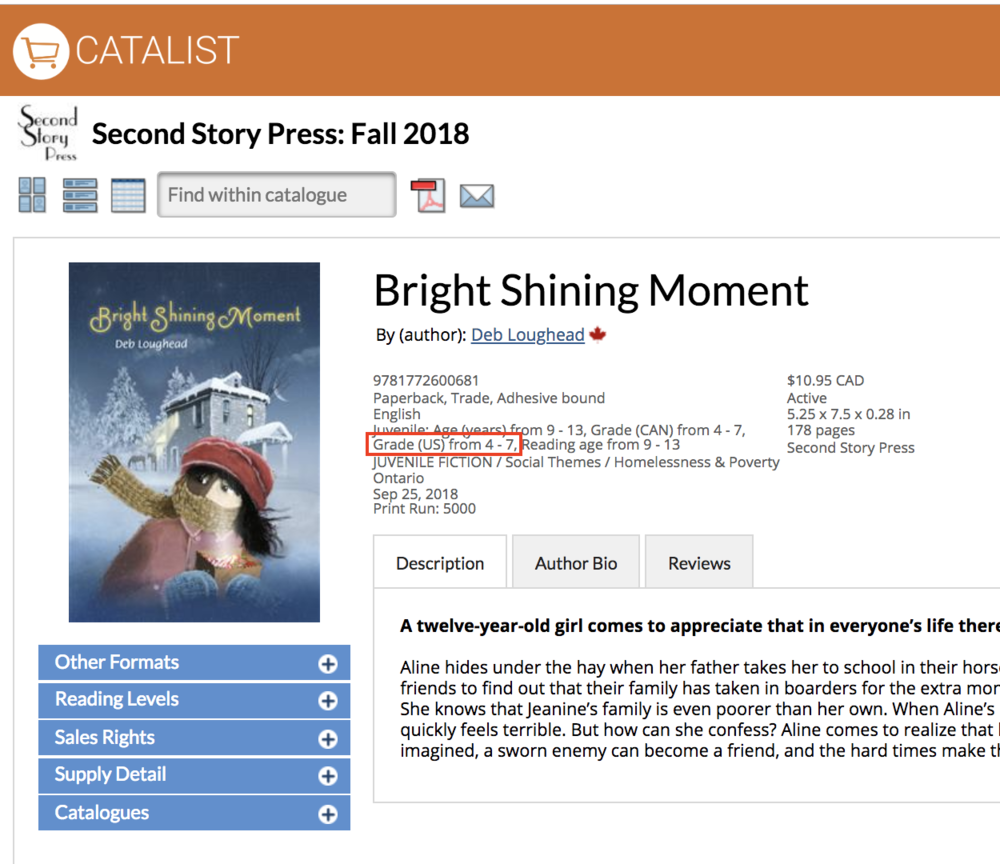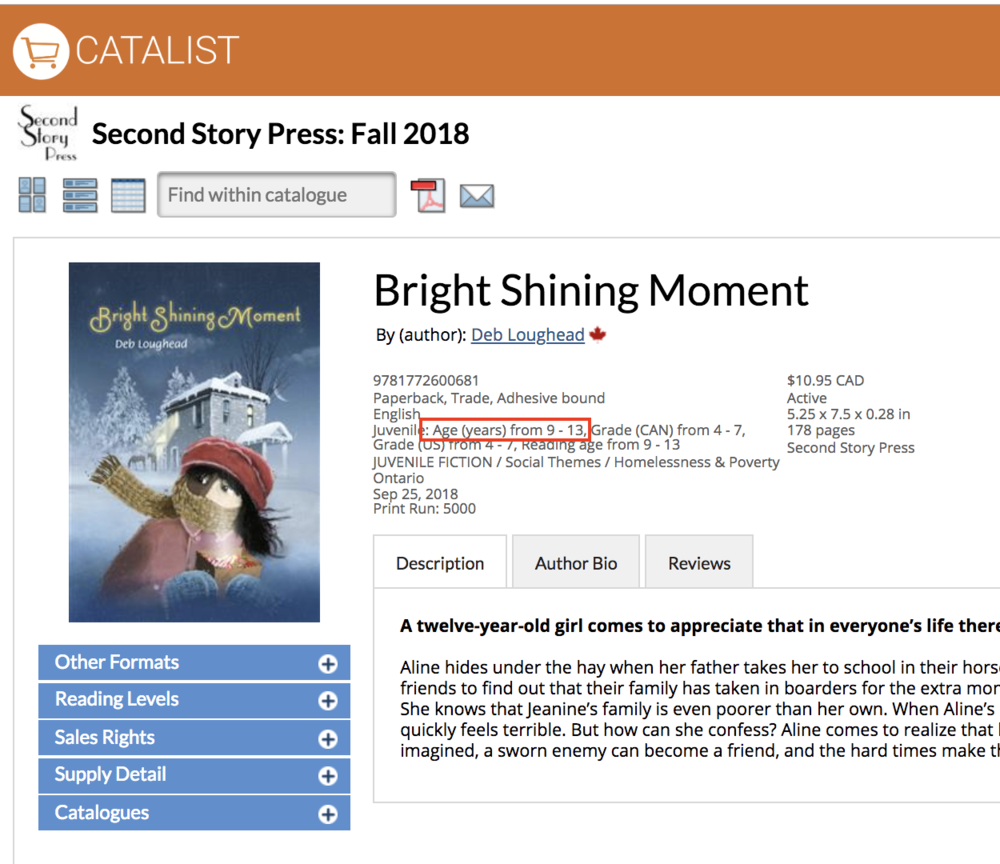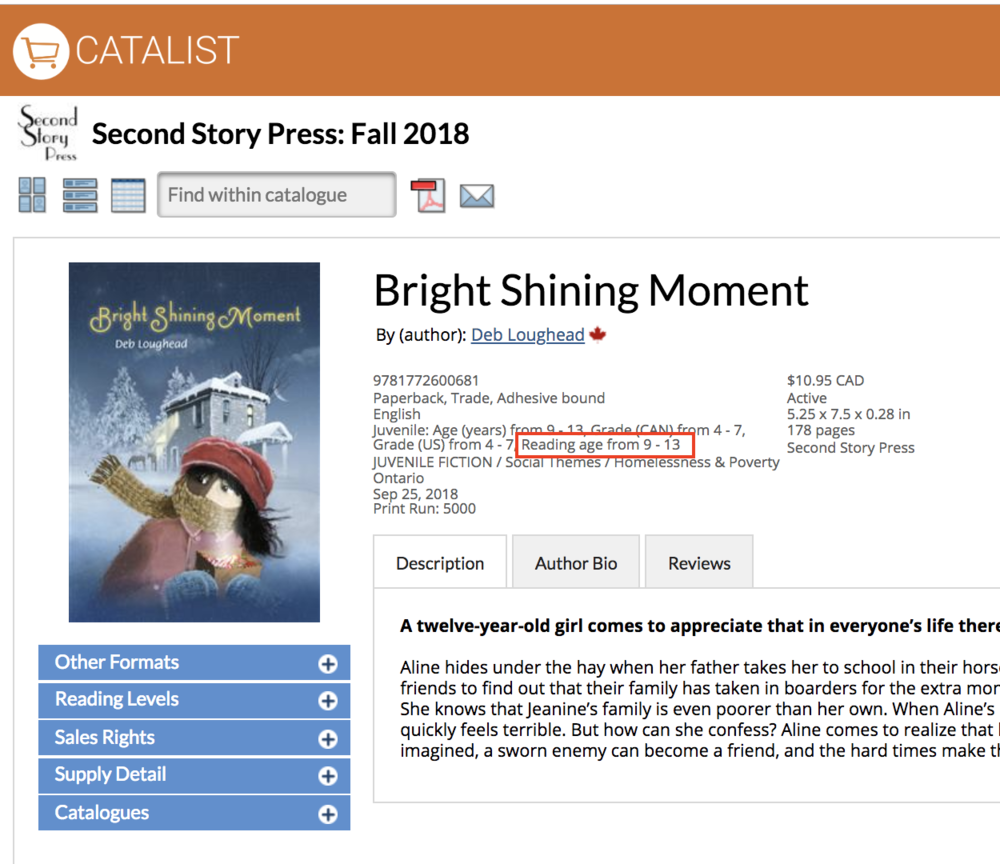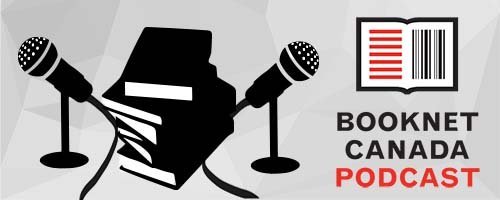It is a truth universally acknowledged, that all titles should include at least one <audience> composite in their ONIX.
However, as to the level of accuracy of that information — the consensus didn't get that far. And so, we see this:
It may not be as overtly cringeworthy as some of the other trends we've seen, but that doesn't mean it should slip into common practice.
We know, deep down, what publishers are trying to convey: that this book has cross-generational appeal. But it's the Kobayashi Maru of marketing — there's no book in existence that is appropriate for readers 0 - 99. And by trying to include everyone, it ends up alienating its core audience. Someone in their 40s, who reads at an adult level, probably isn't going to buy their five-year-old a book about a murder trial, just like they're most likely not going to relax on the beach with an early-reader coming-of-age story. And a student in Grade 12 English is unlikely to ace their book report on an illustrated collection of seasonal poems (especially when you can do A Handmaid's Tale in costume now).
These are all real examples of books where the publisher has indicated an interest age of 0 - 99. And therein lies the problem: Most people see interest age and reading age and think calendar age. So let's break down these terms:
Interest age: A way to convey that the book's contents, topic, and style generally match the abilities of a typical child within an age range.
Reading age: A technical measure of the book's complexity (e.g., style, word choice, etc.), which examines the comprehension required against what's typically expected from the age range.
The two terms actually measure different qualities of your book. What's often overlooked is that the two concepts have a symbiotic relationship. The outcomes of each need to be considered, as well as how those outcomes relate to each other. For example, How the Grinch Stole Christmas may appeal to children and adults alike, but in all honesty, an adult reading at an adult level who has never encountered the story before won't enjoy it the same way an adult who read it in their youth or who is reading it to a child will.
Nostalgia is a powerful marketing tool, but it shouldn't be considered when filling out the Audience composite because consumers don't even see the information relayed in the audience composite. This information is pulled by retailers, selectors, libraries, etc. A wide age range — especially for an adult title — is as useful to your book's marketing as Jar Jar Binks is to the Star Wars universe.
But we get that the Audience composite is messy at best — what about the books with crossover appeal?!, you may cry. No matter how you approach it, odds are that you're going to step in something you didn't mean to the further you wade in. And that's okay! As long as you're basing your assessments on reputable sources and relaying the basics as truthfully and accurately as possible, industry experts (the retailers, wholesalers, etc.) will be able to place your books in front of their ideal readers.
Adult books
Pick a lane
There's an unwritten rule that, if followed, will cut down on your workload and worry extensively. If the book is meant for an adult trade audience, you don't need to add an age range, period. An adult reader will choose your book based on their own preferences, and the main criteria for how a bookseller will organize your title in their store is based on its BISAC code. So all you really need to do, metadata-wise, is indicate the proper lane.
For our first example, here's a book that includes adult themes, is about 9,000 pages of dragon-filled fantasy, and is intended for the general trade market.
 |
The tags <Audience> <AudienceCodeType> List 29 <AudienceCodeValue> List 28 |
The Choices
| List | Value | Definition | Relevant to A Game of Thrones? |
|---|---|---|---|
| 28 | 01 | General/Trade | Yes: adult subject matter and adult reading level |
| 28 | 02 | Children's/Juvenile | Noooooooo, nope, nuh-uh |
| 28 | 03 | Young Adult | Could be, but the accessibility of the language may be an issue and the high volume of sex and violence may not be suitable for younger teens |
Which translates to:
Similar to good social media etiquette, if your book contains intense scenes of violence, drug use, etc., it's probably best to add content warnings. Repeating the previous tags but choosing "22" instead of "01" in list 29 gets you access to list 203: ONIX Adult Audience rating. It's not required but, again, it's a good practice to include — even if your book doesn't have any "trigger-warning" worthy material.
This is all adult books really require: a market and any potential content warnings. Including a recommended age range is counter-intuitive (and a lot more work). That's why, when it comes to adult titles, we recommend letting your BISAC codes do the talking. Does anyone ever need to see more than the subject FICTION / Fantasy / Dragons & Mythical Creatures in order to pick up a book? (Let's be honest with ourselves, the answer is no.)
And if you're producing adult-level educational materials, you can pull your codes from the same list. Though you may sell in multiple markets (i.e., both trade and academic), it has little bearing on your Audience Type. Audience Type should always answer this question: "Who was the product created for?"
Juvenile books
If your book is part of that zany, info-laden world of juvenile products, then hold on to your dragons because it's going to be a bumpy ride.
The first thing you need to keep in mind is that you're not marketing to the readers themselves, but rather to their gatekeepers: the teachers, librarians, and parents who are expecting your books to meet certain standards so they feel confident approving your book for their young readers. This is why you want to make sure that you, as a publisher, do your homework (because you're selling to people who actually assign homework).
Added information
Juvenile titles should always include <AudienceRange> with an interest age. It's also strongly recommended to include <Complexity> where possible, along with an accurate reading age.
Since you can support values of more than one type, you can get fairly specific with your book's reading age, interest age, grade assessments, and reading levels (or quantitative text leveling). These ranges should be narrow. Many experienced librarians and teachers will not consider a book that has a wide or wonky age range. The difference developmentally between an average nine-year-old and an average three-year-old means that a book is unlikely to satisfy the needs of both, so its purchase by an institution or acceptance into a children's program is also unlikely. Choosing an age range should never be done on a whim; always consult an expert in the field or use scientific evaluation to set this value.
Reading levels
Reading levels are quantified measurements of your book's text complexity, which are often set by third-party organizations. They help to identify the level at which a child is reading and matches them with appropriate books that will help them grow as a reader. This is separate from reading age, which measures the relative difficulty of your book, and which, in turn, informs the reading level. Reading levels are metrics that are often created and used by educators and can be a requirement for course adoption. These measurements can take months to complete, so it's best practice to submit your book as early as possible.
You aren't required to assign a reading level to your book, but doing so boosts discoverability and is crucial to being whitelisted not only for children's booksellers, but also for literacy programs and course adoptions. Juvenile books, whether they're fact or fiction, have the potential to capture major sales in both the academic and trade markets — but, again, if your book is intended for a trade audience, then that should be made clear from your choice of value from list 28. The <AudienceRange> and <Complexity> composites are additional but important pieces of data that will give your book cross-market appeal.
Audience Range: Keep it narrow
The tags:
<AudienceRange>
<AudienceRangeQualifier> List 30
<AudienceRangeValue> Numerical fun times OR list 77
<AudienceRangePrecision> List 31
The Choices
| List | Value | Name | Notes | What it looks like in CataList |
|---|---|---|---|---|
| 30 | 11 | US school grade range | Use list 77 to fill in values. |  |
| 30 | 16 | Interest age, months | Ideal for books designed for those two and under; maximum age is 36 months. |  |
| 30 | 17 | Interest age, years | You'll use this a lot. |  |
| 30 | 18 | Reading age, years | You'll also use this a lot. |  |
| 30 | 26 | Canadian school grade range | Use list 77 to fill in values. |  |
Complexity: Where you brag about your reading levels
The tags
<Complexity>
<ComplexitySchemeIdentifier> List 32
<ComplexityCode> Your result
The Choices
| List | Value | Name | Notes | What it looks like in CataList |
|---|---|---|---|---|
| 32 | 05 | Fountas & Pinnell Text Level Gradient | Fountas & Pinnell |  |
| 32 | 06 | Lexile Measure | The Lexile Framework for Reading |
The age-old story
This is all to say: Please don't announce to the world that your book is ideal for all ages, because, as sure as we are that individuals of all ages will enjoy it, it's not scientifically appropriate for the entire population. So don't let those who are guaranteed to love or benefit from your book miss out on a magical reading adventure because your data lacked a crucial piece of information.
If that's not reason enough to keep your age ranges narrow and accurate, think of it this way: Every time you indicate that a book is great for ages 0 - 99, a centenarian somewhere feels left out. And they shouldn't because books are meant for all ages, but not all books are meant for every age.



















Featuring River in an Ocean: Essays on Translation edited by Nuzhat Abbas.